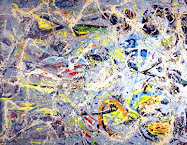Biskra Blue Nude. 2015. Pastel, Charcoal & Graphite. 17" x 14.75." Casey Klahn.
Sketch, White Nude on Blue. 2015. Graphite & Pastel. @6." Casey Klahn.
Blue Nude. Digital Drawing. Large. Casey Klahn.
My inspiration for the blue nudes originates with the 1907 work of the same subject by Henri Matisse, shown below. A disrobed woman in Algeria was his model, and the painting reflects his search for new imagery in north Africa.
Matisse, in Biskra, Algeria: "I went from one surprise to the next - without being able to tell if my amazement came from the vastness of the country, or the new types of human being I was seeing, or from purely pictorial emotions."
A conversation between Picasso and Walter Pach, while viewing Matisse's Blue Nude: "Does that interest you?" asked Picasso. "In a way, yes...it interests me like a blow between the eyes. I don't know what he is thinking." "Neither do I," said Picasso. "If he wants to make a woman, let him make a woman. If he wants to make a design, let him make a design. This is between the two."
Late in his life, in 1952, Matisse revisited the Blue Nude title with his series of famous cut-outs.
Henri Matisse, 1907, Blue Nude (Souvenir de Biskra), Nu bleu: Souvenir de Biskra, oil on canvas, 92.1 x 140.3 cm (36 1/4 x 55 1/4 in.), Cone collection, Baltimore Museum of Art.





































